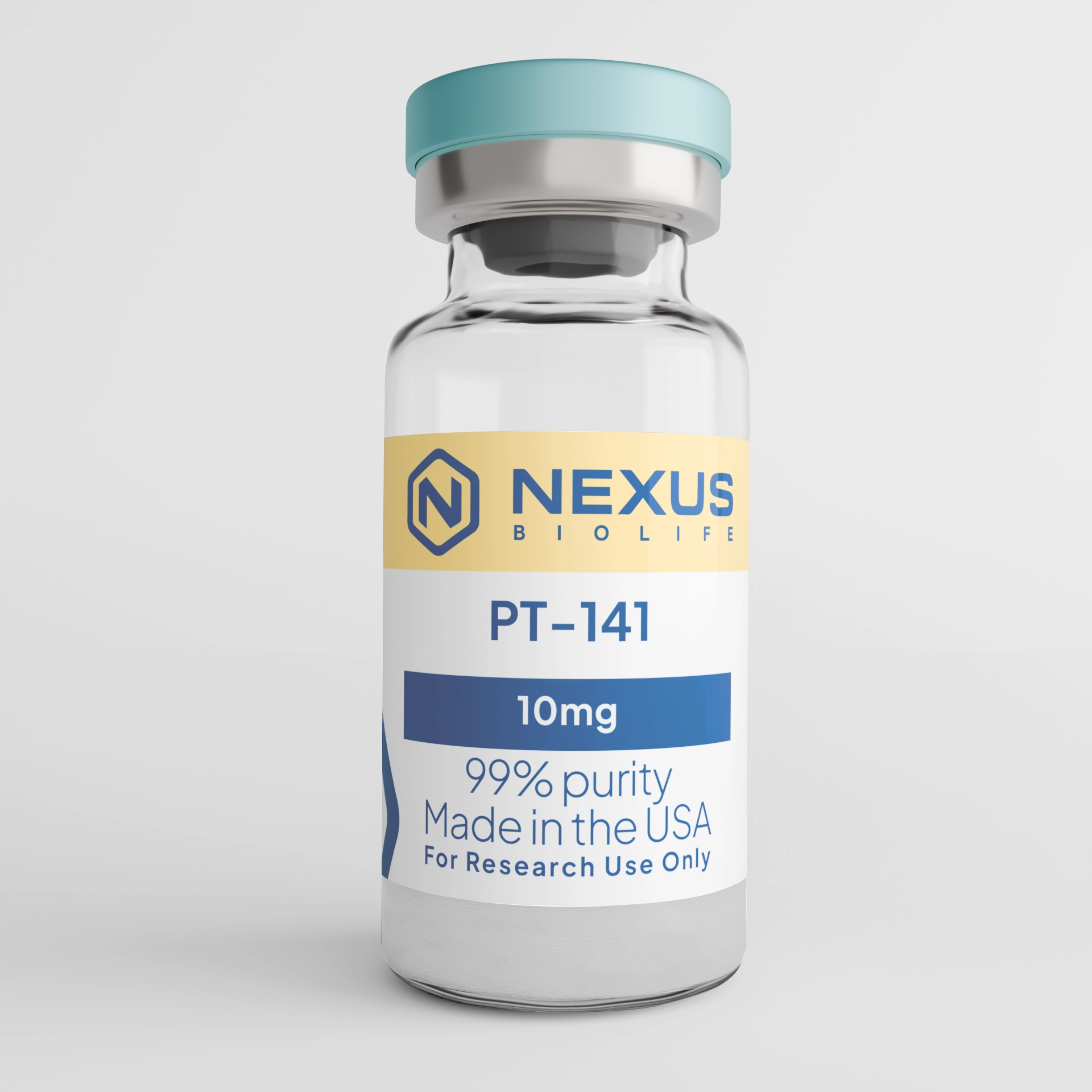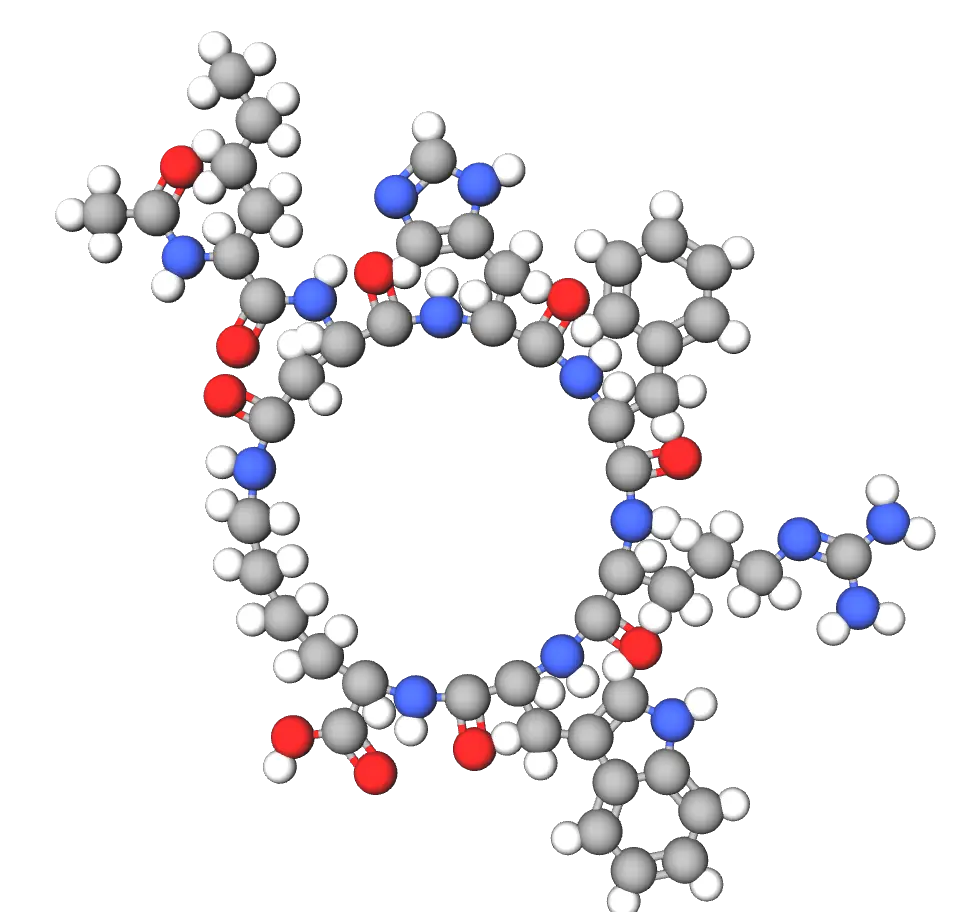
PT-141, also known as Bremelanotide, is a synthetic peptide meticulously prepared for scientific inquiry. This product is synthesized with high purity for laboratory investigations. It is developed for use in various research applications. PT-141 is designated solely for research and development purposes.

PT-141 features a cyclic structure with the amino acid sequence Ac-Nle-cyclo[Asp-His-D-Phe-Arg-Trp-Lys]-OH, resulting in a molecular formula of C50H68N14O10 and a molecular weight of approximately 1025.2 g/mol. It incorporates non-natural modifications like norleucine (Nle) and D-phenylalanine (D-Phe), along with a lactam bridge between Asp and Lys residues, which confer greater stability and resistance to enzymatic degradation than linear analogs. As an active metabolite of melanotan II without the C-terminal amide, it exhibits a solid state and good solubility in aqueous solutions like 0.9% saline.
In practical terms, PT-141 is provided as a lyophilized powder with purity typically exceeding 98%, verified through HPLC and mass spectrometry. Its pharmacokinetic profile in models includes a half-life of around 2-2.7 hours, with high bioavailability and protein binding of about 21%. We ensure transparency in our quality assurance, testing each batch for consistency so you can focus on your experiments without concerns over variability.
PT-141, also known as bremelanotide, is a synthetic cyclic heptapeptide analog of alpha-melanocyte-stimulating hormone (α-MSH), designed to activate melanocortin receptors and investigate pathways related to sexual arousal and function in research models. This lactam-bridged peptide offers enhanced potency and selectivity compared to native hormones, making it a precise tool for in-vitro studies on neuroendocrine signaling and behavioral responses. As always, our PT-141 is supplied strictly for research purposes and in-vitro use only—not for human consumption or any therapeutic applications.
PT-141 acts as a non-selective agonist at melanocortin receptors, with strong affinity for MC1R, MC3R, MC4R, and MC5R, though it shows particular potency at MC3R and MC4R in the central nervous system. By elevating cyclic AMP (cAMP) levels in receptor-expressing cells, it modulates neural pathways in the hypothalamus, such as the paraventricular nucleus, to influence sexual arousal and erectile responses without direct peripheral vascular effects. This central mechanism involves increased dopamine release in areas like the medial preoptic area, enhancing lordosis or erection in model systems.
Additionally, PT-141 may reduce inflammation and ischemia by limiting cytokine production and supporting reperfusion, potentially through NF-κB modulation. We're passionate about explaining these details accessibly—PT-141 provides a window into how melanocortin signaling bridges neuroendocrine and behavioral functions, ideal for rational dissection in controlled assays.
In summary, PT-141 serves as a potent melanocortin agonist for advancing understanding of central arousal mechanisms, inflammation modulation, and related pathways, with its cyclic design enabling targeted in-vitro explorations. Its versatility in modeling complex neuroendocrine interactions reflects our dedication to quality peptides that inspire scientific curiosity with integrity. Exclusively for research use, PT-141 embodies our friendly expertise in building a collaborative community. Let's partner to uncover more, one logical study at a time.
PT-141's receptor agonism makes it suitable for in-vitro and ex-vivo research on sexual dysfunction, neuroendocrine regulation, and inflammatory responses. In cellular models expressing MC4R, such as HEK-293 cells, it has been used to measure cAMP production and explore arousal pathways, demonstrating dose-dependent effects on spontaneous erections in animal tissues. Studies in diabetic or PDE5 inhibitor-resistant models highlight its potential to improve erectile function via central mechanisms, often synergistically with other agents like sildenafil.
Beyond sexual health, PT-141 supports investigations into hypoactive desire disorders, where it modulates hypothalamic signaling to influence libido and energy homeostasis. Its anti-inflammatory properties have been probed in reperfusion injury models, showing reduced ischemia via melanocortin pathways. We encourage its use in comparative receptor-binding assays or combined with visual stimuli in behavioral simulations, and our educational resources can help optimize these for insightful, reproducible results.
To preserve PT-141's stability for your experiments, store the lyophilized powder at -20°C or below in a dry, light-protected environment to prevent degradation. Reconstitute with sterile bacteriostatic water or saline to concentrations of 1-2 mg/mL, gently swirling to dissolve without foaming that could affect the cyclic structure. Prepared solutions should be aliquoted and used fresh, with short-term storage at 2-8°C or freezing for longer periods, avoiding repeated freeze-thaw cycles.
Our testing confirms its robustness, but monitor pH neutrality for optimal activity. If handling questions arise, we're here with evidence-based, step-by-step guidance to keep your research on track.
PT-141, also known as bremelanotide, is a synthetic cyclic heptapeptide analog of alpha-melanocyte-stimulating hormone (α-MSH), designed to activate melanocortin receptors and investigate pathways related to sexual arousal and function in research models. This lactam-bridged peptide offers enhanced potency and selectivity compared to native hormones, making it a precise tool for in-vitro studies on neuroendocrine signaling and behavioral responses. As always, our PT-141 is supplied strictly for research purposes and in-vitro use only—not for human consumption or any therapeutic applications.
PT-141 acts as a non-selective agonist at melanocortin receptors, with strong affinity for MC1R, MC3R, MC4R, and MC5R, though it shows particular potency at MC3R and MC4R in the central nervous system. By elevating cyclic AMP (cAMP) levels in receptor-expressing cells, it modulates neural pathways in the hypothalamus, such as the paraventricular nucleus, to influence sexual arousal and erectile responses without direct peripheral vascular effects. This central mechanism involves increased dopamine release in areas like the medial preoptic area, enhancing lordosis or erection in model systems.
Additionally, PT-141 may reduce inflammation and ischemia by limiting cytokine production and supporting reperfusion, potentially through NF-κB modulation. We're passionate about explaining these details accessibly—PT-141 provides a window into how melanocortin signaling bridges neuroendocrine and behavioral functions, ideal for rational dissection in controlled assays.
In summary, PT-141 serves as a potent melanocortin agonist for advancing understanding of central arousal mechanisms, inflammation modulation, and related pathways, with its cyclic design enabling targeted in-vitro explorations. Its versatility in modeling complex neuroendocrine interactions reflects our dedication to quality peptides that inspire scientific curiosity with integrity. Exclusively for research use, PT-141 embodies our friendly expertise in building a collaborative community. Let's partner to uncover more, one logical study at a time.
PT-141 features a cyclic structure with the amino acid sequence Ac-Nle-cyclo[Asp-His-D-Phe-Arg-Trp-Lys]-OH, resulting in a molecular formula of C50H68N14O10 and a molecular weight of approximately 1025.2 g/mol. It incorporates non-natural modifications like norleucine (Nle) and D-phenylalanine (D-Phe), along with a lactam bridge between Asp and Lys residues, which confer greater stability and resistance to enzymatic degradation than linear analogs. As an active metabolite of melanotan II without the C-terminal amide, it exhibits a solid state and good solubility in aqueous solutions like 0.9% saline.
In practical terms, PT-141 is provided as a lyophilized powder with purity typically exceeding 98%, verified through HPLC and mass spectrometry. Its pharmacokinetic profile in models includes a half-life of around 2-2.7 hours, with high bioavailability and protein binding of about 21%. We ensure transparency in our quality assurance, testing each batch for consistency so you can focus on your experiments without concerns over variability.

PT-141's receptor agonism makes it suitable for in-vitro and ex-vivo research on sexual dysfunction, neuroendocrine regulation, and inflammatory responses. In cellular models expressing MC4R, such as HEK-293 cells, it has been used to measure cAMP production and explore arousal pathways, demonstrating dose-dependent effects on spontaneous erections in animal tissues. Studies in diabetic or PDE5 inhibitor-resistant models highlight its potential to improve erectile function via central mechanisms, often synergistically with other agents like sildenafil.
Beyond sexual health, PT-141 supports investigations into hypoactive desire disorders, where it modulates hypothalamic signaling to influence libido and energy homeostasis. Its anti-inflammatory properties have been probed in reperfusion injury models, showing reduced ischemia via melanocortin pathways. We encourage its use in comparative receptor-binding assays or combined with visual stimuli in behavioral simulations, and our educational resources can help optimize these for insightful, reproducible results.
To preserve PT-141's stability for your experiments, store the lyophilized powder at -20°C or below in a dry, light-protected environment to prevent degradation. Reconstitute with sterile bacteriostatic water or saline to concentrations of 1-2 mg/mL, gently swirling to dissolve without foaming that could affect the cyclic structure. Prepared solutions should be aliquoted and used fresh, with short-term storage at 2-8°C or freezing for longer periods, avoiding repeated freeze-thaw cycles.
Our testing confirms its robustness, but monitor pH neutrality for optimal activity. If handling questions arise, we're here with evidence-based, step-by-step guidance to keep your research on track.
